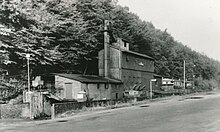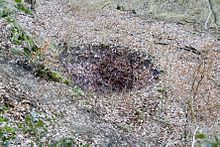Plaetzgesbank colliery
| Plaetzgesbank colliery | |||
|---|---|---|---|
| General information about the mine | |||
| Information about the mining company | |||
| Funded raw materials | |||
| Degradation of | Hard coal | ||
| Geographical location | |||
| Coordinates | 51 ° 24 '56.4 " N , 7 ° 4' 3.5" E | ||
|
|||
| Location | Essen-Heisingen | ||
| local community | eat | ||
| Independent city ( NUTS3 ) | eat | ||
| country | State of North Rhine-Westphalia | ||
| Country | Germany | ||
| District | Ruhr area | ||
The Plaetzgesbank colliery , also referred to as: Plätzgesbank, Plätzkesbank, Plätgesbank (presumably identical to Raetzgesbank ), was a hard coal mine in the Essen district of Heisingen , north of the Ruhr , directly across from the Heinrich colliery (whose headframe is part of the " Route Industrial Culture ") located.
facts and figures
- 1777 Issuance of the prospect's license
- 1781 Grant of concession, start of mining
- 1802 Authorization Registration
- 1815 In time limits
- 1816 After opening up a new route , dismantling again
- 1822 In time limits
- 1827 excavation day drive Heinrich, mining
- 1834 dismantling, day drives 2 and 3 in operation
- 1837 In time limits
- In operation in 1838
- 1844 out of service
- 1886 Re-commissioning, but only for a short period of time
- 1922 Re-commissioning, excavation of new tunnels
- 1923 cessation of work, occupation by French soldiers
- 1924 to 1926 maintenance work and guarding
- 1927 shutdown
- 1933 re-establishment with a shaft and a weather tunnel
- 1,956 requests for extension of validity of an exception, extending the authorization for shooting (step 2), extension of the mining permit, operating plan Supplement - mining seam Geitling
- 1957 Applications for extension of the shooting license (stage 2), the lay-up time of the hoisting rope , the period of validity of the annual operating plan, extension of the lay-up time of the hoisting rope
- 1958 Defects found when driving over the struts in seam Kreftenscheer 2, dismantling of remaining piers in seam Kreftenscheer 2, further extension of the lay-up time of the hoisting rope, supplement to the operating plan , filling of the day outlets, production cessation
- 1959 shutdown
- 1960 Ruhrknappschaft becomes the legal successor to the Plaetzgesbank colliery
- 1964 Repayment of the remaining security to H. Dickerhoff, Haltern
Brief description
- Re-establishment : 1933
- Owner : Plaetzgesbank Union
- Head : Heinrich Dickerhoff, Haltern in Westfalen, Birkenstrasse 20
- Headquarters : Essen-Heisingen, Wuppertaler Straße 178
- Mining Office : Essen 1, Flachsmarkt 2
- Landesoberbergamt Dortmund
- Railway stations for general cargo and wagon loads: Essen-Kupferdreh , -Rellinghausen and -Rüttenscheid
- Berechtsame : 289200 m²
- Dismantling : production shaft , weather tunnel
- Seams : Geitling, Mausegatt and Kreftenscheer 2
- Thickness : 106 cm, 100 cm, 40 cm
- Type of coal : lean coal , anthracite coal
- Storage : flat incident to 25 °, to 28 ° D = 100%
- Construction site : 975 m strike length, 500 m cross-cutting alignment , 40 m strike length / 20 m flat excavation height
- Maximum production : year: 1954, quantity: 27543 tons, employees: 84
- End of operation : 1959
- Succession : None
- Markscheider : J. Oertgen, Essen
- Last manager : Josef Abst, Holzwickede
- Current condition : Remains of a brick wall, probably that of the conveyor shaft, are still present directly above a pinge .
General
The former Kleinzeche Plaetzgesbank in Essen-Heisingen, once located between Ostpreußenstraße and Wuppertaler Straße, has largely disappeared from the consciousness of mine enthusiasts and people researching mining. It remained the only colliery in Essen-Heisingen that did not belong to Carl Funke until the end . Perhaps that is the reason for their more or less neglectful treatment, even with mining tours in this area, which was formerly characterized by coal mining. The Mausegatt , Kreftenscheer 2 and Geitling seams were mined . The coal deposits in the Mausegatt and Kreftenscheer 2 seams came to an end in the foreseeable future in the mid-1950s, and the same applied to the Geitling seam. For this reason, a mining contract for Geitling seam within the Geviertfeld of the Heinrich colliery was concluded with Heinrich BAG as early as 1956 . Throughout its existence, Plaetzgesbank had to struggle with problems, not just financial ones, which, even after its shutdown with the demolition, the proper restoration of the surface and the final payment of the security, continued until the end of 1964. The excellent anthracite coal mined on Plaetzgesbank was hardly suitable as a house fire , because it developed an immense heat, which sooner or later burned the stoves to pieces. As an energy supplier, however, it was in great demand far beyond the borders of Essen. Once a week, trucks from Brussels were even parked on the coal field below the coal bunker to load coal on behalf of the “Belgian State Mint”.
Used literature
- Yearbook for the Ruhr coal district, Essen, each different year
- Yearbook of German Mining, Essen, each different year
- Horst Detering: From evening light to dwarf mother - 400 years of mining in Heisingen . 1st edition. Klartext, Essen 1998, ISBN 978-3-88474-739-1 .
- Joachim Huske : The coal mines in the Ruhr area . Data and facts from the beginning to 2005. 3rd revised and expanded edition. German Mining Museum Bochum , Bochum 2006, ISBN 3-937203-24-9 .
- Peter Nowacki: Charlotte Collin and the Kleinzeche Plaetzgesbank . 1st edition. CreateSpace Independent Publishing Platform, Essen 2016, ISBN 978-1-5307-8269-7 .


